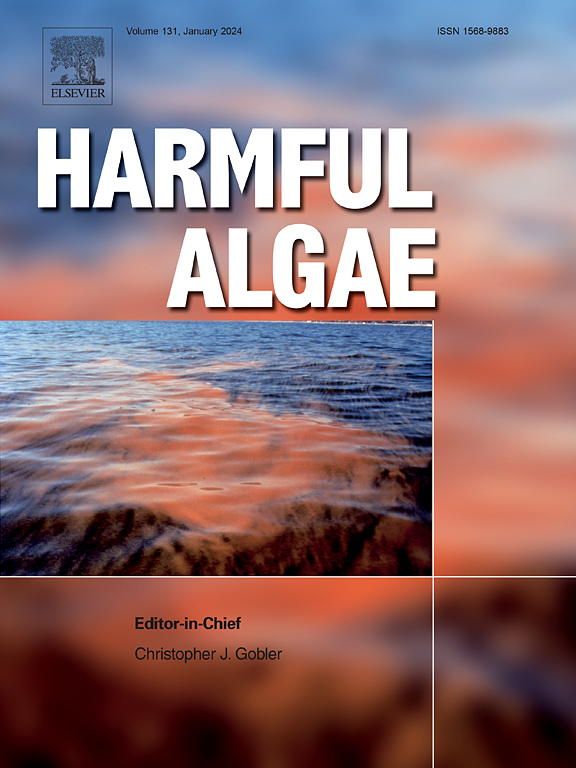Domoic acid induces developmental stage-specific effects on microglia in zebrafish
IF 4.5
1区 生物学
Q1 MARINE & FRESHWATER BIOLOGY
引用次数: 0
Abstract
Harmful algal blooms (HABs), driven by warming oceans and increased eutrophication, are negatively affecting aquatic ecosystems as well as human health. Blooms of diatom Pseudo-nitzschia spp. produce a neurotoxin, domoic acid (DA), which can be concentrated by filter feeders, including shellfish. Consumption of DA-contaminated seafood causes amnesic shellfish poisoning. DA causes well-established effects on neurons, inducing neurotoxicity by binding to ionotropic glutamate receptors. However, its effects on non-neuronal cells including microglia, the resident immune cells in the brain, are less well understood. Microglia play critical roles in brain health, and disruptions in microglial activity during development can have long-term impacts on brain function and disease risk. The objective of this study was to examine the effects of developmental DA exposure on microglia using zebrafish (Danio rerio). We characterized effects of DA exposure on microglial abundance and morphology at two developmental stages (2 and 4 days post-fertilization (dpf)). We additionally assessed impacts on cell death, cytokine expression, and startle response behavior. In older larvae (4 dpf), microglial effects occurred only at the highest dose (0.3 ng DA per larvae) and coincided with severe morphological defects. In contrast, 2 dpf exposure to lower doses (0.1 ng DA per embryo) caused transient tremors without gross abnormalities but exposure to either 0.1 or 0.3 ng DA per larvae increased microglial abundance and altered microglial morphology. In contrast, 4 dpf exposure to 0.3 ng DA per larvae reduced microglial numbers. Increases in mRNA levels of il1b, il4, and tgfb were observed after 4 dpf exposure, but no significant cytokine changes were detected at 2 dpf. Overall, the effects of DA are highly developmental stage-specific, with microglial reactivity occurring at doses that do not cause gross morphological changes. These findings suggest that neuroinflammation may arise at lower DA doses, indicating a potential mechanism for subtle toxic effects and emphasizing the need for further research to better understand the consequences of low-dose DA exposure on microglial function.
软骨藻酸诱导斑马鱼小胶质细胞发育阶段特异性效应
在海洋变暖和富营养化加剧的驱动下,有害藻华(HABs)正在对水生生态系统和人类健康产生负面影响。硅藻假nitzschia的大量繁殖产生一种神经毒素,软骨藻酸(DA),它可以被滤食性动物浓缩,包括贝类。食用受da污染的海鲜会导致失忆性贝类中毒。DA通过与嗜离子性谷氨酸受体结合而对神经元产生神经毒性。然而,它对非神经元细胞的影响,包括小胶质细胞,大脑中的常驻免疫细胞,还不太清楚。小胶质细胞在大脑健康中起着至关重要的作用,发育过程中小胶质细胞活动的中断可能对大脑功能和疾病风险产生长期影响。本研究的目的是利用斑马鱼(Danio rerio)研究发育性DA暴露对小胶质细胞的影响。我们研究了DA暴露对两个发育阶段(受精后2天和4天)小胶质细胞丰度和形态的影响。我们还评估了对细胞死亡、细胞因子表达和惊吓反应行为的影响。在年龄较大的幼虫(4 dpf)中,小胶质细胞效应仅在最高剂量(每只幼虫0.3 ng DA)时发生,并且与严重的形态缺陷同时发生。相比之下,2 dpf暴露于较低剂量(每个胚胎0.1 ng DA)会引起短暂性震颤,没有明显异常,但暴露于每只幼虫0.1或0.3 ng DA会增加小胶质细胞的丰度,并改变小胶质细胞的形态。相比之下,每只幼虫暴露于0.3 ng DA的4 dpf会减少小胶质细胞数量。暴露于4 dpf后,观察到il1b、il4和tgfb mRNA水平升高,但暴露于2 dpf时未检测到明显的细胞因子变化。总的来说,DA的作用是高度发育阶段特异性的,小胶质细胞反应性在剂量下发生,不会引起大体形态改变。这些发现表明,低剂量的DA可能会引起神经炎症,这表明了微妙毒性作用的潜在机制,并强调需要进一步研究以更好地了解低剂量DA暴露对小胶质细胞功能的影响。
本文章由计算机程序翻译,如有差异,请以英文原文为准。
求助全文
约1分钟内获得全文
求助全文
来源期刊

Harmful Algae
生物-海洋与淡水生物学
CiteScore
12.50
自引率
15.20%
发文量
122
审稿时长
7.5 months
期刊介绍:
This journal provides a forum to promote knowledge of harmful microalgae and macroalgae, including cyanobacteria, as well as monitoring, management and control of these organisms.
 求助内容:
求助内容: 应助结果提醒方式:
应助结果提醒方式:


